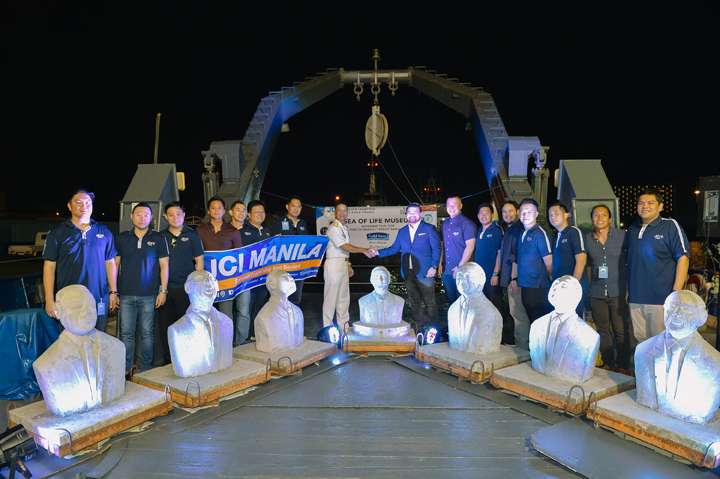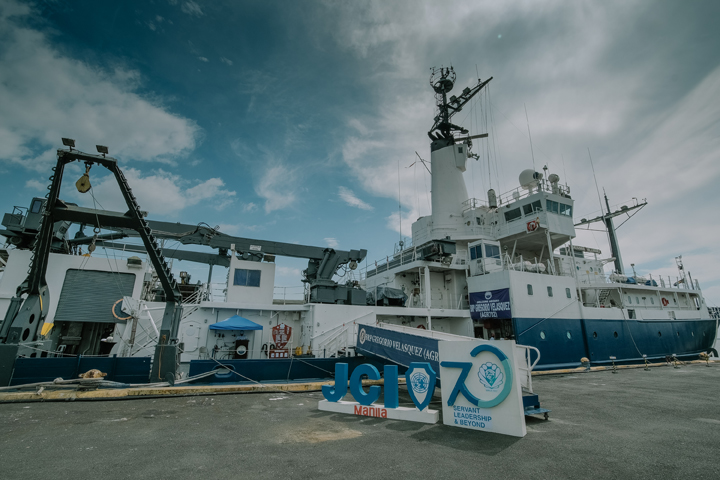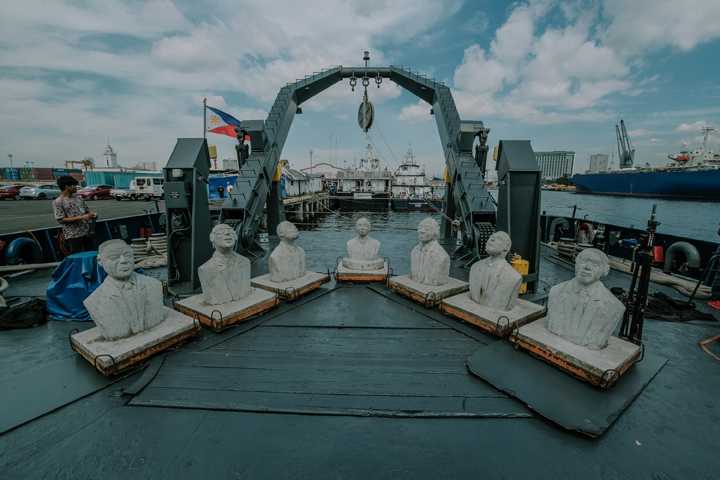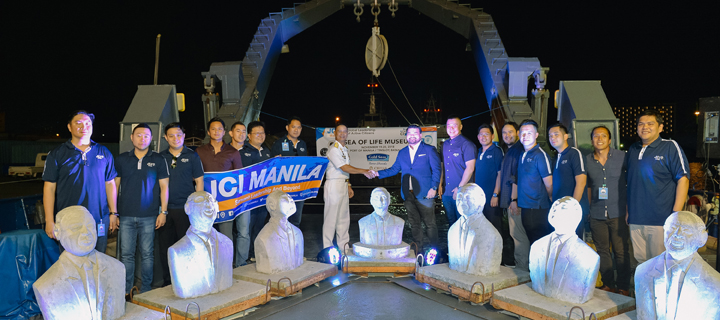JCI Manila, in partnership with Gold Seas Tuna Chunks, launches the first and official underwater exhibition that will become artificial coral reefs.
Gold Seas Tuna Chunks’ dedication to responsible and sustainable fishing practices, which has enabled it to be certified dolphin-safe, has expanded this commitment to help rehabilitate Philippine coral reefs and revive the rich marine ecosystem.

Artwork with a Purpose
The Philippines is considered a center of marine biodiversity in the world, with coral reefs stretching 26,000 kms nurturing more species of fish and corals than any other marine environment on earth. At present, reef degradation caused by factors such as pollution, coral bleaching, destruction of mangroves, and unsustainable fishing methods have affected the Philippines’ coral reefs. Only 5% of the Philippines’ coral reefs remain in good condition.
It can take thousands of years for natural coral reefs to regenerate. Long-lasting, artificial reefs are a useful and faster way to help restore the reef systems to a natural and productive balance. These multi-purpose artworks will help serve the function of natural coral reefs: serve as nurseries for growing fish and protect the shoreline from erosion. They can also help to boost eco-tourism, and provide jobs in a green economy.
Supporting Marine Life
In 2011, Junior Chamber International (JCI) Manila launched project Sea of Life. It is a marine environment awareness effort through artificial reefs deployment, coral transplantation, mangrove planting, coastal clean-up, and marine environmental awareness seminars.
Since then, Sea of Life has made a positive environmental impact in marine ecosystems in Batangas, Bohol, Cagayan de Oro, Davao, Cebu, and Iloilo. This month, Sea of Life is set to launch the first ever underwater exhibition that aims to rehabilitate corals.
It has taken the exhibition almost two years to fully be installed in order to ensure that best practices are applied according to all government and environmental compliance requirements.
JCI Manila has been closely working with various government and environmental agencies to ensure feasibility of this project. With the support and guidance of the Department of Environment and Resources (DENR), the Philippine Navy, and LGUs, JCI Manila and Gold Seas Tuna Chunks will deploy locally designed underwater sculptures that will serve as artificial reefs.

Travel to Drop Site
In coordination with the Philippine Navy, the BRP Gregorio Velasquez or AGR 702, an impressive 279 feet long vessel with hydrographic survey and maritime research capabilities, will transport the sculptures to the installation site. From Pier 13 at Port Area, Manila, the AGR702, complete with a crew of mariners, will set off for the waters of Tingloy, Batangas.
In close coordination with DENR’s Biodiversity Management Bureau, the project was given the go-signal to cover less than 1,000 sqm in land area. Safety and accessibility were the key factors in identifying the location. The site must be safe from strong currents, must not disrupt or destroy existing corals, and must be accessible for easy monitoring and analysis.
A site off the shores of Tingloy, Batangas was identified as an ideal site, with flat and sandy bottom so sculptures are kept stable on the seabed, with 40 feet in depth so the corals can benefit from sunlight and be accessible to both leisure snorkelers and professional divers.
A Professional Dive Team
Planning the dive logistics was a challenge, having to work with factors such as the weight of the sculptures. Underwater, the installation will be carried out by the dive team composed of 20 divers, a combination of the country’s Naval Special Operations Group (NAVSOG) and certified dive masters and underwater photographers from JCI Manila.
The team will use the AGR 702, two outrigger boats, two rubber boats and five naval lift bags in order to safely drop the sculptures. The team also made sure to incorporate the Green Fins approach in the plan. Green Fins is a recognized environmental set of standards with a comprehensive management approach to provide guidance and support for any diving and snorkeling activity.
Creating an Underwater Museum
The sculptures will be dropped in the waters on November 20, 2018. Six sculptures will be installed featuring JCI luminaries who exemplify outstanding corporate citizenship and passion for nation-building, namely, Kofi A. Anan, Ramon V. Del Rosario, Sr., Henry Giessenbier, Washington Z. Sycip, Artemio L. Vergel De Dios, and Alfonso T. Yuchengco. Each sculpture is 3-4 ft tall and weigh 370-400 kgs.

To create the sculptures, the committee consulted marine scientists and the Reef Ball Foundation (reefball.org), an international non-profit foundation that introduced a formulation of globally recognized artificial reef modules.
The sculptures are made of pH-neutral cement that is not harmful to the sea and at the same time will protect and promote marine life. The concrete features 10,000 micro silica to create a high strength, abrasion resistant concrete that has a pH similar to natural seawater, which has a pH of 8.3. This is unlike regular concrete which has a surface pH as high as 12, and can inhibit the settlement and growth of many species of marine life, including larval corals.
Micro silica gives the sculpture an expected life of 500 years or more. A variety of surface textures that enhance the settlement of marine life will also applied so corals can easily grow.
A Living Coral Reef
Artificial reefs tend to develop in predictable stages. First, where an ocean current encounters a vertical structure, it creates a plankton-rich upwelling that provides a reliable feeding spot for small fish such as sardines and minnows, which draw in pelagic predators such as the tuna and shark. Next come creatures seeking protection from the ocean’s lethal openness-hole and crevice dwellers such as the grouper, snapper, squirrelfish, eel, and triggerfish. Predators such as the jack and barracuda also appear. Over months and years, the reef structure becomes encrusted with algae, tunicates, hard and soft corals, and sponges as the ecosystem grows.
Artificial reefs can show quick increases in local fish population, coral reef and algae growth in the first 1.5 years, and a complete reef structure covered in corals after its third year. In fact, the Sea of Life Barangay Saimsim, Batangas leg last 2015 has had encouraging results. The team returned to the site after three years and saw colorful marine fauna flourishing on all 30 underwater dome sculptures.
The installation of the first sculptures is just Phase 1. Every year, Sea of Life Museum will drop more sculptures at the same site until a total of 50 sculptures is completed within four to five years. Each batch deployed will be closely coordinated with DENR Calabarzon and Provincial Environment and Natural Resources Office-Batangas.
With these efforts, organizations like JCI Manila and Gold Seas Tuna Chunks can contribute to the preservation, rehabilitation, and restoration of our marine ecosystems for this generation and those to come.
Liked this post? Follow SwirlingOverCoffee on Facebook, YouTube, and Instagram.


